Commandants in the Dachau camp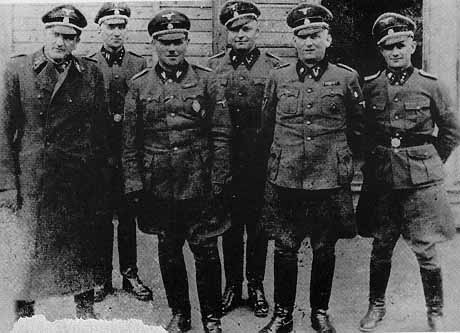 The photograph above shows six of the SS men on the staff at Dachau in 1934. Theodor Eicke, who became the second Commandant at Dachau in 1933 is the second man from the left in the back row. When the Dachau camp was first opened on March 22, 1933, the guards were police officers with the Munich police, but after only a few weeks, SS soldiers were assigned to guard duty in the camp. The first Commandant of Dachau was SS Standartenführer Hilmar Wäckerle, who began using that title on April 19, 1933. Wäckerle was instructed by Heinrich Himmler, the head of the SS and the acting Police Chief of Munich, to draw up a set of rules for discipline in the camp. His rules were extremely harsh and a number of prisoners died after being punished. The deaths in the Dachau camp came to the attention of the Munich prosecutor after Sophie Handschuch made a formal complaint in 1933, demanding to know the true cause of death of her son who had been an inmate at Dachau. Other prisoners who died in the early days of the camp were Dr. Rudolf Benario, Fritz Dressel, Sepp Götz, Ernst Goldmann, Arthur Kahn, and Erwin Kahn. Karl Lehrburger and Wilhelm Aron, both Jewish, also died as a result of harsh treatment in the Dachau camp. Herbert Hunglinge committed suicide to escape the unbearable conditions in the camp. After an investigation by the Munich police, Wäckerle was charged with murder for the deaths of Louis Schloss on May 16, Leonard Hausmann on May 17, Dr. Alfred Strauss on May 24 and Sebastian Nefzger on May 25. Dr. Strauss and Louis Schloss were both Jewish. Because of the criminal charges, Himmler was forced to relieve Wäckerle of his command, as of June 25, 1933. The charges against Wäckerle were later dropped, but he was dismissed from his job as Commandant and sent to fight on the Eastern front, where he was killed in action. Wäckerle was replaced by Theodor Eicke who became the new Commandant. Eicke was also killed in action after he was transferred to the Eastern front. In June 1934, Eicke was given the title of Inspector General and the authority to approve all punishments in all the camps. His promotion was a reward for accepting the assignment to execute Ernst Röhm, the Commander of the Storm Troopers, after Röhm refused Hitler's order to kill himself. Röhm was openly homosexual and Eicke was also rumored to be a homosexual. SS Oberführer Heinrich Deubel replaced Eicke as the Commandant of Dachau, but was dismissed after a few months for being too lenient with the prisoners. Deubel was replaced by SS Standartenführer Hermann Baranowski. SS Oberführer Hans Loritz was the 5th Commandant of Dachau, replacing Baranowski. Loritz is shown below in a photo of a poster in the Dachau Museum. After he was captured by the Allies, he committed suicide before he could be put on trial. 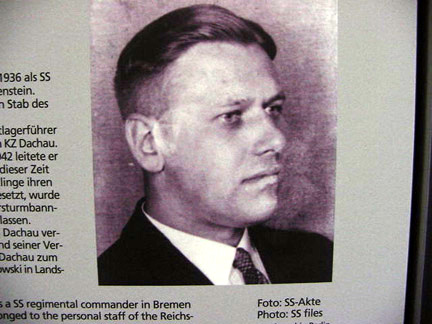 SS Hauptsturmführer Alexander Piorkowski was the 6th Commandant of Dachau, replacing Hans Loritz. Piorkowski was dismissed for being too harsh and was expelled from the Nazi party because of his cruelty to the prisoners. Piorkowski was executed by the Allies after being convicted by an American Military Tribunal at Dachau. 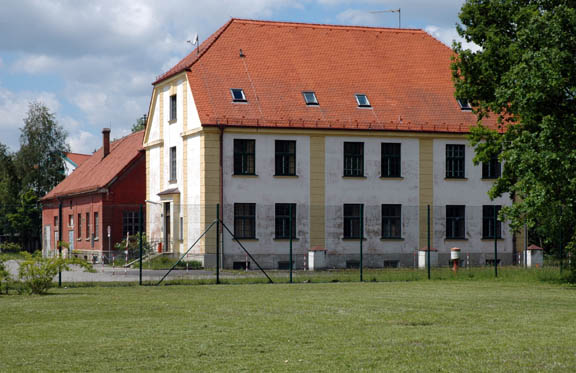 The photo above shows the Administration Building at Dachau, where the Commandant and his staff had their offices. The Commandant's house was torn down in 1985. SS Obersturmbannführer Martin Gottfried Weiss replaced Piorkowski; he was the 7th Commandant of Dachau. Weiss was put on trial by an American Military Tribunal at Dachau in November 1945; he was convicted and was later hanged at the Landsberg am Lech prison. Many of the prisoners testified on his behalf; although Weiss was not charged with any specific atrocity, he was convicted of participating in a "common plan" to commit war crimes. The photo below shows Martin Gottfried Weiss standing in the courtroom at Dachau as he is identified by Dr. Franz Blaha, a Czech political prisoner who made a sworn affidavit on May 3, 1945 in which he accused the Dachau staff of killing prisoners in the gas chamber at Dachau. 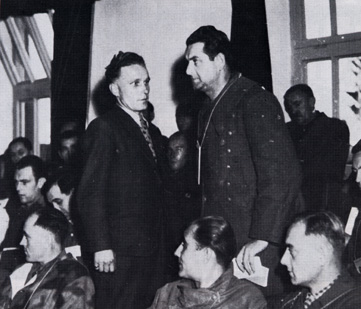 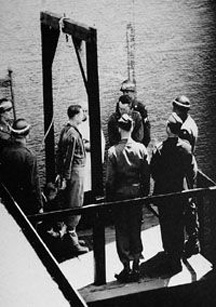 The last of the 8 Commandants of Dachau was Wilhelm Eduard Weiter, who replaced Martin Gottfried Weiss on November 1, 1943. On April 26, 1945, Weiter left the Dachau camp with a transport of prisoners. Martin Gottfried Weiss had been brought back to the Dachau camp in March 1945 when the Mühldorf sub camp, where he was the commander, was evacuated. As the highest ranking SS officer at Dachau, Weiss took over as Commandant after Weiter left the camp. Weiter committed suicide on May 6, 1945 at Schloss Itter, a subcamp of Dachau, according to the Dachau Museum. Egon Zill had the title of Lagerführer in the Dachau camp, before being assigned to the job of Commandant of the Natzweiler camp; later he became the Commandant of Flossenbürg. He was put on trial by a German court in 1950 and sentenced to 15 years in prison; he returned to the town of Dachau to live after he completed his prison term and died there in 1974, according David L. Israel, author of the book "The Day the Thunderbird Cried, published by emek press in 2005. The following quote is from "The Day the Thunderbird Cried": Egon Zill, by now a member of the Death's Head formation was the Commandant of Dachau Concentration Camp in 1941. Having received his Death's Head unit training in Dachau, he was familiar with all the terrors the camp had to offer its inmates. Egon Zill became one of the most sadistic commandants in the history of concentration camps. Not only did he devise new and organized methods of torture for the unfortunate prisoners, he took joy in taking part in the punishment personally, or else watching from the sidelines as the prisoners died at the hands of equally sadistic guards. Zill thrived on watching men beaten, drowned, hung, and broken until their bodies were unrecognizable masses of bone and skin. A tag attached to their toes listed an identification number so they could be properly recorded in the record books as having died from a heart attack or some other medical ailment. David L. Israel was a soldier in the U.S. Army in 1945, assigned to an intelligence group which investigated the Dachau camp for war crimes after it was liberated. As part of his duties, Israel interviewed the survivors of Dachau. About half of the survivors of Dachau had only been in the camp for two weeks or less. They had been brought to the main Dachau camp from the sub-camps and before that, they had been in other Nazi concentration camps; many of the prisoners at Dachau when it was liberated had previously been evacuated from Auschwitz when it was abandoned in January 1945. They were eager to tell the American liberators about the years of abuse that they had endured. The following quote is also from the book "The Day the Thunderbird Cried": Egon Zill had his dogs trained to react to the raising of his arm. On special amusement days, Zill would have a table of food placed in front of the starving prisoners who stood at attention. Should a person relax his body, the dogs would react automatically. As time went by and Zill became impatient, he raised his arm signaling the dogs into action. They attacked the genital areas of the prisoners until they were dead. At this point the bored commandant would leave the scene. [...] Having the prisoners sing anti-Semitic songs as they dug pits to be filled with stones, only to have the stones dug up and used to fill other pits, was a common pastime for the guards. At other times, they would bind the prisoners' hands and feet and have them crawl on the ground grunting like pigs. As the prisoners approached the pigsty, food was put out for their meal to be eaten by the pigs. The SS men stood watching as the bound prisoners fought with the pigs for the food. This type of torture was used with Jews, priests, Jehovah's Witnesses and Poles. Prisoner classificationPrisoner BadgesLabor Allocation at DachauPriests at DachauJews at DachauDachau LifeBack to Dachau Concentration CampBack to Table of ContentsHomeThis page was last updated on February 07, 2010 |